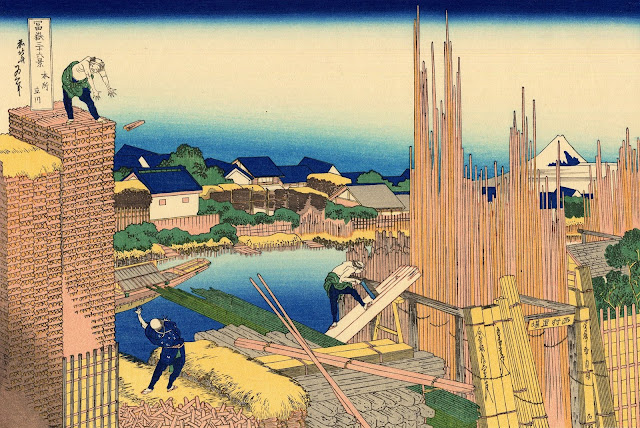KATSUSHIKA HOKUSAÏ / 葛飾 北斎 (1760-1849)
Fujiyama / 富士山 (3, 776 m -12,389 ft)
Japon
In 36 vues du Mont Fuji n° 31 - Ono Shindon dans la Province de Suraga
À propos des 36 vues du mont Fuji
Trente-six vues du mont Fuji (富嶽三十六景)
(Fugaku Sanjūrokkei) est une série d'estampes de paysages créées par
l'artiste japonais ukiyo-e Katsushika Hokusai (1760-1849). La série
représente le mont Fuji depuis différents endroits du Japon et à
différentes saisons et conditions météorologiques. Les trente-six
tirages originaux furent si populaires qu'Hokusai decida d'élargir la
série de dix estampes supplémentaires.
Les toutes premières
impressions de 1830-33 semblent aujourd'hui estompées par rapport aux
versions habituellement vues mais sont plus proches de la conception
originale de Hokusai. Les tirages originaux présentent un ciel bleu
volontairement irrégulier, ce qui augmente la luminosité du ciel et
donne du mouvement aux nuages.
La montagne
Le mont Fuji (3 776,24 m -12 389 pieds) ou Fujiyama (富士山)
est situé sur l'île de Honshu. Il est le plus haut sommet montagneux du
Japon. Plusieurs noms lui sont attribués : "Fuji-san", "Fujiyama" ou,
de manière redondante, "Mt . Fujiyama". Habituellement, les locuteurs
japonais appellent la montagne "Fuji-san". Les autres noms japonais du
mont Fuji sont devenus obsolètes ou poétiques comme : Fuji-no-Yama (La
montagne de Fuji), Fuji- no-Takane ( Le haut sommet du Fuji), Fuyō-hō
(Le pic du Lotus) et Fugaku). Le mont Fuji est un stratovolcan actif
dont la dernière éruption remonte à 1707-08. Le mont Fuji se trouve à
environ 100 kilomètres (60 mi) au sud-ouest de Tokyo et peut être vu de
là par temps clair.
Le cône exceptionnellement symétrique du mont
Fuji, recouvert de neige plusieurs mois par an, est un symbole bien
connu du Japon et il est fréquemment représenté dans l'art et les
photographies, ainsi que visité par les touristes et les alpinistes.
Le
mont Fuji est l'une des trois montagnes sacrées du Japon avec le mont
Tate et le mont Haku. C'est aussi un endroit spécial de beauté scénique
et l'un des sites historiques du Japon.
Il a été ajouté à la Liste du
patrimoine mondial en tant que site culturel le 22 juin 2013. Selon
l'UNESCO, le mont Fuji a "inspiré des artistes et des poètes et fait
l'objet de pèlerinages depuis des siècles". L'UNESCO reconnaît 25 sites
d'intérêt culturel dans la localité du mont Fuji. Ces 25 sites
comprennent la montagne elle-même, le sanctuaire Fujisan Hongū Sengen et
six autres sanctuaires Sengen, deux maisons d'hébergement, le lac
Yamanaka, le lac Kawaguchi, les huit sources chaudes d'Oshino Hakkai,
deux moules d'arbres de lave, les vestiges du culte Fuji-kō dans le la
grotte Hitoana, les chutes Shiraito et la pinède Miho no Matsubara ;
tandis que sur les basses Alpes du mont Fuji se trouve le complexe du
temple Taisekiji, où se trouve le siège central du bouddhisme Nichiren
Shoshu.
L'artiste
Katsushika Hokusai (葛飾 北斎?) est un peintre, dessinateur et graveur japonais du 18e siècle, spécialiste de l’ukiyo-e, ainsi que l'auteur d'écrits populaires, surtout connu sous le nom de Hokusai(北斎?),
ou son surnom de Gakyōjin, littéralement « Vieux Fou de dessin. Au
cours de ses soixante-dix ans de carrière, il a réalisé une œuvre
considérable de quelque 3 000 tirages couleur, des illustrations pour
plus de 200 livres, des centaines de dessins et plus de 1 000 peintures.
Il a rapidement abandonné le sujet étroit traditionnellement associé à
l'école du « monde flottant » (ukiyo-e) dont il faisait partie, comme
les images d'acteurs populaires et de courtisane. Son œuvre influença
de nombreux artistes européens, en particulier Paul Gauguin, Vincent van
Gogh, Claude Monet et Alfred Sisley, et plus largement le mouvement
artistique appelé japonisme. Les Trente-six vues du mont Fuji (1831–1833) comptant en réalité 46 estampes dont La Grande Vague de Kanagawa (1831) sont ses œuvres les plus connues.
______________________________________
2024 - Gravir les montagnes en peinture
Un blog de Francis Rousseau
-%20Ono_Shindon_in_the_Suraga_province.jpg)
-%20Mishima_pass_in_Kai_province%20N)%2029%20-%201830.jpg)

-Tsukada_Island_in_the_Musashi_province%20n%C2%B0%2016-%201830.jpg)















